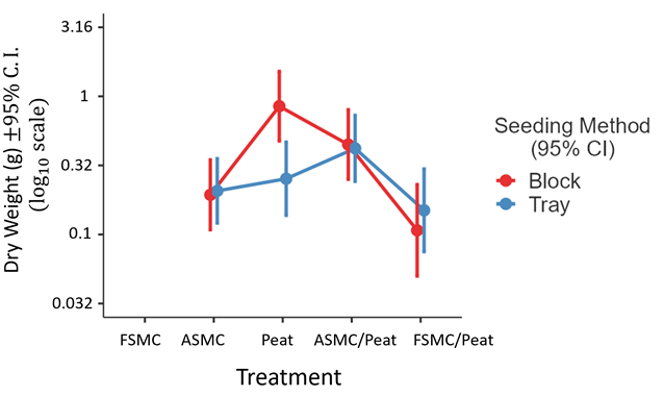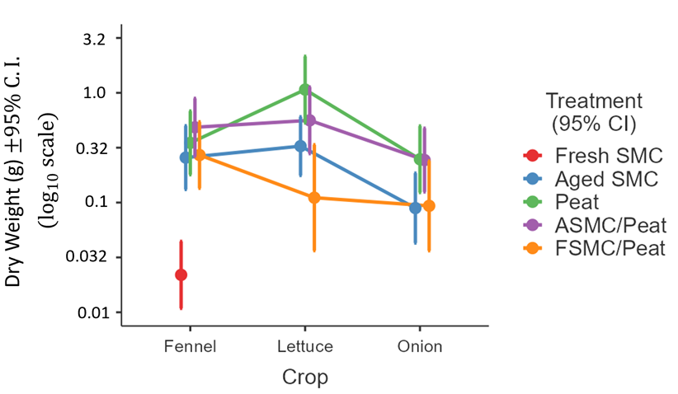

Sustainable Agriculture Student Research Project
Spent mushroom compost as a replacement for peat in growing mediaAlex Bisset, Department of Sustainable Agriculture and Food Systems, 2021 |
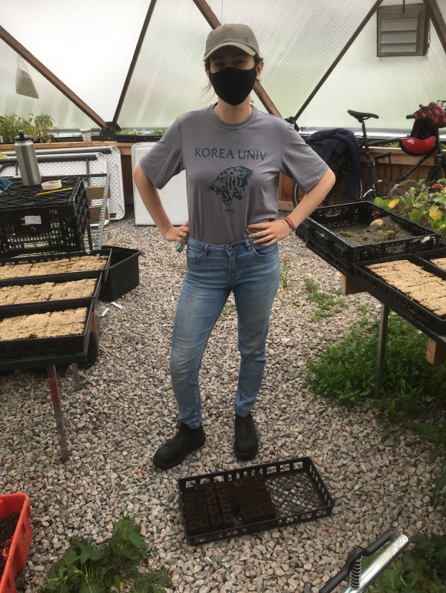 Introduction
Introduction
Peat is commonly harvested for agricultural and horticultural transplant media purposes. Peat is a finite resource and an important carbon sink and therefore renewable alternatives should be considered. Spent mushroom compost (SMC) is the residual compost waste generated by the mushroom production industry. SMC has valuable properties for seedling production such as water-holding capacity and high porosity. One concern in the use of SMC as a growing media for seedlings is its high level of salinity. Previous research has shown that aging compost has resulted in significantly lower salinity levels and the production of more successful crops. In this paper, 1-year aged SMC, fresh SMC, and an organic peat mix were compared. Onion (Allium cepa), lettuce (Lactuca sativa), and fennel (Foeniculum vulgare) have a low tolerance to saline soils, so these crops were chosen in order to determine how well salt-intolerant crops would grow in both fresh SMC and aged SMC. The two different seeding techniques used were soil blocking and planting in black plastic trays with separate compartments.
Hypothesis
Two main hypotheses:
- Plants grown in the aged SMC will perform the same or better than plants grown in the peat mix.
- Plants grown in the fresh SMC will be outperformed by both the peat mix and aged SMC.
Secondary hypothesis:
- The soil blocking seeding technique will work as well as seeding into black plastic plug trays.
Methods
Location: KPU Farm, Garden City Lands, Richmond B.C.
Treatments
- Growing media
- Organic peat mix (control)
- 1-year aged SMC
- Fresh SMC
- 1-year aged SMC in a 1:1 ratio with the peat mix
- Fresh SMC in a 1:1 ratio with the peat mix
- Crops
- Lettuce (Lactuca sativa)
- Onion (Allium cepa)
- Fennel (Foeniculum vulgare)
- Seeding method
- Soil blocks
- Plastic plug tray
Steps
- Each cell was seeded with two seeds and labeled with the growing medium, crop, and main plot number.
- The seedlings sat in the germination chamber for one week and then they were moved onto a table with a heated mat.
- The seedlings were later moved outside when the conditions in the dome were too hot.
- The seedlings were irrigated as needed and grown for six weeks.
Experimental Design: Completely randomized split-plot with four replicates
- Main plot factor: Seeding method (soil block or plastic plug tray)
- Subplot factors: Crop and growing medium
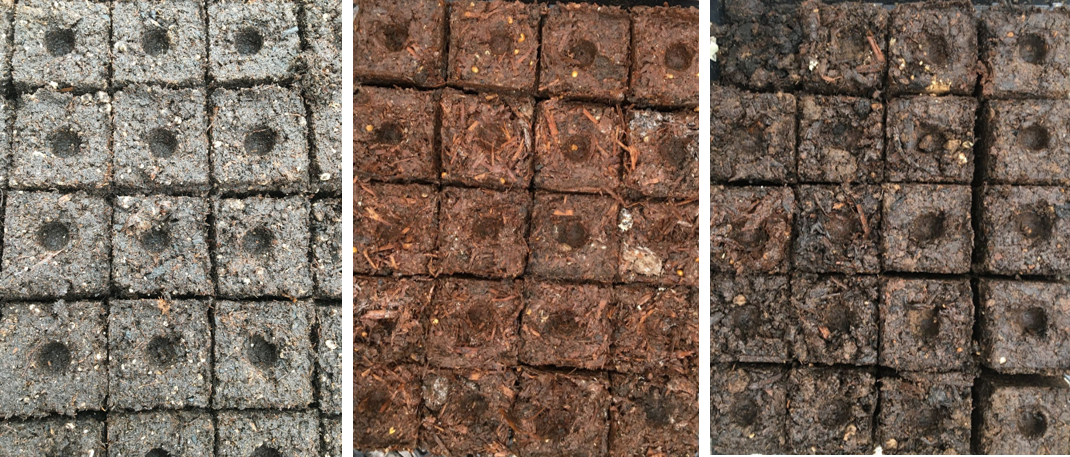
Figure 1. Soil blocks made from peat (left), fresh spent mushroom compost (centre), and aged spent mushroom compost (right)
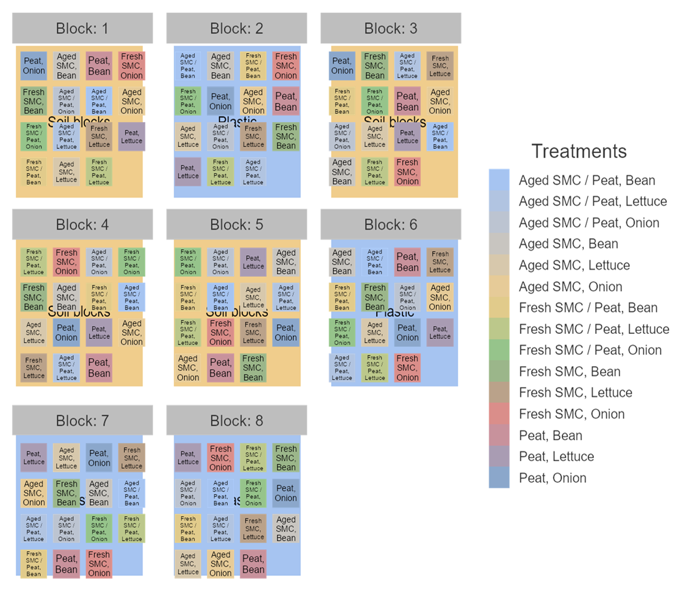
Figure 2. Completely randomized split-plot design with eight main plots and 120 subplots.
Data collection
- Dry weight of each seedling (grams)
- Germination rate (how many seedlings germinated per unit)
- Salinity (dS/m)
Statistical analysis
- A Shapiro-Wilk test determined that Log10 transformation of dry weight data was necessary to satisfy the assumption of normal distribution.
- Transformed data were analyzed by mixed model analysis, with transplant method, crop, and growing medium as fixed effects, and main plot as the random effect, in the GAMLj module of the jamovi interface for R.
Results
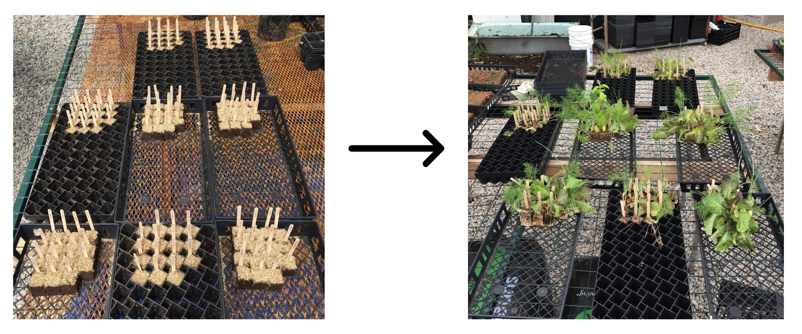
| Medium | EC (dS/m) |
| Horticultural peat | 1.00 |
| Aged mushroom compost | 5.38 |
| Fresh mushroom compost | 11.35 |
| Peat and aged mushroom compost blend | 2.30 |
| Peat and fresh mushroom compost blend | 8.15 |
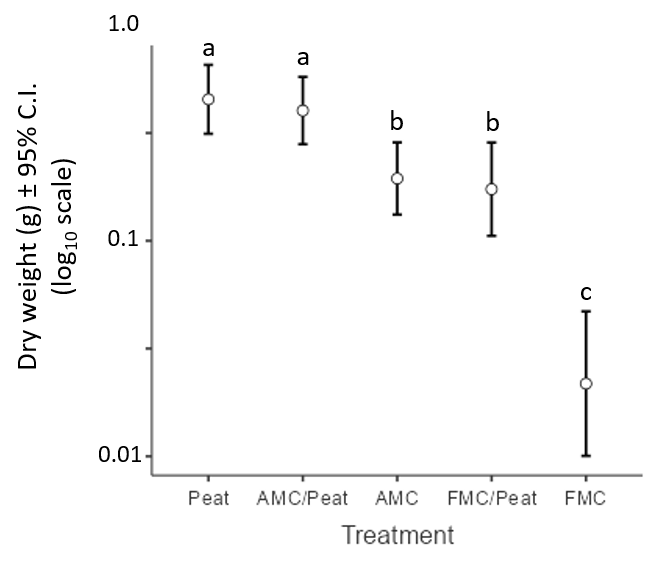
Figure 4. Plant dry weight by growing medium six weeks after seeding. Seedlings were grown in pure peat (Peat), aged mushroom compost (AMC), fresh mushroom compost (FMC), or a 1:1 blend of peat and aged or fresh mushroom compost (AMC/Peat or FMC/Peat, respectively). Error bars denote the 95% confidence interval around each mean. Means labeled with the same letter do not differ significantly (Bonferroni test, α = 0.05).
No significant effect of tray type was detected (p = 0.265) (Figure 5). Plants performed as well in soil blocks as in plastic plug trays.
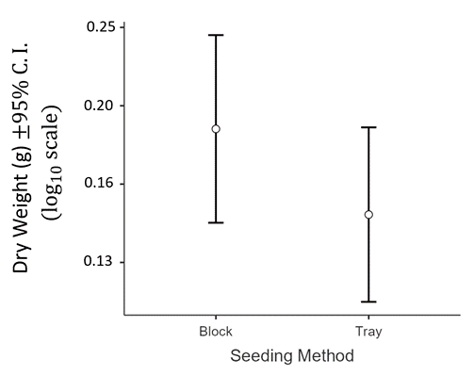
Figure 5. Plant dry weight by seeding method six weeks after seeding. Seedlings were grown in soil blocks and horticultural plastic. Error bars denote the 95% confidence interval around each mean.
An interaction was detected between growing medium and seeding method (p = 0.005)(Figure 6). Plants grown in peat soil blocks were larger than those grown in peat in plastic plug trays. Seeding method did not affect seedling growth in the other media.
Figure 6. Interaction between growing medium and seeding method effects on seedling dry weight six weeks after seeding. Crops were onion (Allium cepa), lettuce (Lactuca sativa), and fennel (Foeniculum vulgare). Seeding methods were soil blocks (Block) or plastic plug trays (Tray). Seedlings were grown in pure peat (Peat), aged spent mushroom compost (ASMC), fresh spent mushroom compost (FSMC), or a 1:1 blend of peat and aged or fresh spent mushroom compost (ASMC/Peat or FSMC/Peat, respectively). Error bars denote the 95% confidence interval around each mean.
No significant interaction was detected between crop and seeding method (p = 0.089, data not shown).
Fennel was the only crop to survive in the fresh SMC treatment (Figure 7), so the interaction between crop and growing medium could not be tested. Lettuce appeared to be most sensitive to growing media effects.
Figure 7. Interaction between crop and growing medium on seedling dry weight six weeks after seeding. Crops were onion (Allium cepa), lettuce (Lactuca sativa), and fennel (Foeniculum vulgare). Seedlings were grown in pure peat (Peat), aged spent mushroom compost (ASMC), fresh spent mushroom compost (FSMC), or a 1:1 blend of peat and aged or fresh spent mushroom compost (ASMC/Peat or FSMC/Peat, respectively). Error bars denote the 95% confidence interval around each mean.
Discussion
- SMC should be aged before it is blended into growing media for salt-sensitive seedlings
- Seedling growth in aged SMC can be improved by blending with a less saline material like horticultural peat
- Seedlings grown in horticultural peat performed better in soil blocks than in the plastic trays
- Fennel was the only crop to survive the fresh SMC although the mean dry matter accumulation was less than 1/10 of the mean dry matter accumulation of the fennel seedlings grown in the other treatments
- Moving the soil blocks in order to have a completely randomized design for the experiment made the soil blocks dry out faster and may have reduced their effectiveness in facilitating seedling growth
- The fennel and lettuce seedlings both had a significantly higher dry matter accumulation than the onion seedlings.
Conclusion
- When mixed with horticultural peat, one-year aged SMC is a suitable medium for growing salt-sensitive seedlings such as fennel, lettuce, and onion
- There is no disadvantage to using a soil blocker over the more commonly used horticultural plastic plug trays
Acknowledgments
- Thank you Dr. Rebecca Harbut, Dr. Mike Bomford, Andy Smith, and the KPU farm staff and students for your help with my project
- Spent mushroom compost was donated by Highline Mushrooms

